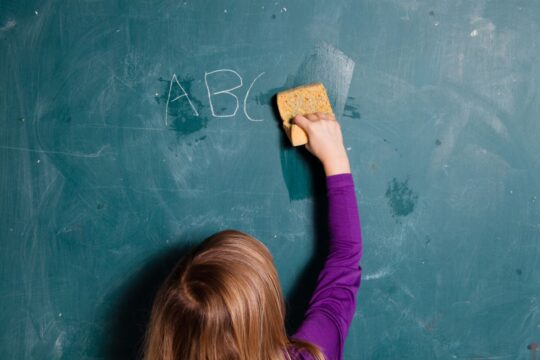School anxiety can start at a very young age. For many students, the excitement of starting school is also paired with feelings of nervousness. While some anxiety is a normal part of adjusting to a new environment, for some children, these feelings can become overwhelming, impacting their ability to focus and enjoy learning.
Whether it’s academic pressure, social challenges, or the fear of failure, it’s no wonder that anxiety is becoming more prevalent in students of all ages. To help students manage these pressures and feel more at ease in the classroom try some of these practical strategies to support students dealing with school-related anxiety.
Recognize the Signs of Anxiety
Anxiety and Depression Association of America states that children with anxiety may appear irritable, and tired, experience headaches, refuse to go to school, exhibit separation anxiety, or act defiant. These symptoms can often be misunderstood as behavioral issues or lack of motivation, when in fact, they may be signs of anxiety.
You need to recognize these signs as an educator so you can respond with empathy. By understanding the root cause of these behaviors, you can take proactive steps to support anxious students before their anxiety escalates. Untreated anxiety can affect a child’s emotional well-being and academic performance.
Provide Distraction Activities
If you notice a student showing any of the signs mentioned, offer them an activity to help distract and calm them. Encourage them to read a book, listen to soft music, or engage in another calming activity. They can ease back into their classwork once they’ve had time to regulate their emotions.
Create a “Safe” Space
Creating a “safe” or “quiet” space for students to go to when they feel their anxiety rises can really be helpful. Consider choosing a corner of the classroom, a space in the hallway, another empty (monitored) room, or the nurse’s office. Once the student has talked to you first, they can go to this space when they feel their anxiety rise.
Incorporate Movement and Hands-on Activities
Research shows that exercise helps reduce stress and anxiety. Even something as simple as having students stand up and stretch between activities can lower their stress levels. American Psychological Association notes that regular physical activity is proven to improve mood and reduce feelings of anxiety.
Beyond physical movement, hands-on activities can also help. For a student feeling anxious, engaging in tactile tasks can serve as a healthy distraction and ease their anxiety. Providing opportunities for both movement and engagement can create a more relaxed and supportive classroom environment.
Teach Relaxation Techniques
It’s quite common for students to feel anxious before a test. To help students relieve some of this anxiety teach them a few stress reduction techniques. Deep breathing exercises can really be effective. Encourage students to breathe in slowly and then breathe out their tension. You can also have students close their eyes and visualize they are taking a test.
Encourage them to imagine themselves doing well on the test and teach students to control their negative thoughts into positive ones. Another great technique is to have students meditate for a few moments before a test. Have them sit still and imagine they are in a comfortable, relaxing place. Tell students to remember this place each time they need a break or are feeling anxious.
Discuss Helpful Interventions
Talk to your students about what helps them when they are feeling anxious. Each child is different so understanding what works best for them is key to creating an effective support system. Ask students to describe how anxiety feels in their bodies and minds, and what situations tend to trigger it. Once you’ve identified their stress points, collaborate with the student to develop a few go-to strategies they can use when they start to feel overwhelmed.
These could include taking deep breaths, using a fidget tool, or going to a designated calm space in the classroom. Encourage students to practice these strategies regularly, not just when anxiety arises. This way, they’re equipped to manage stress before it becomes too overwhelming.
Reduce Stressful Situations
Whenever possible, minimize situations that trigger stress for anxious students. For example, if a student worries about being the last to finish a test, let them take it in a quiet space where they won’t be distracted. If presenting in front of peers makes them anxious, explore alternatives, like allowing them to record their presentation and play it for the class.
If they don’t want to feel singled out by you allowing them to do this then consider asking all students to create their presentation on Gravity or Google Classroom. This small adjustment can significantly reduce performance anxiety and help the student feel more at ease, allowing them to focus on doing their best work without distraction.
Additionally, consider adjusting classroom activities that may unintentionally heighten stress. Group work, for example, can be challenging for students who feel anxious in social situations. Pairing students with classmates that they feel comfortable with or allowing them to choose their partners can make collaborative work feel less intimidating. For some students, offering written alternatives to verbal participation in discussions can help them engage without the stress of speaking in front of others.
Anxiety is common, with research showing that up to 10% of children experience some form of anxiety disorder. This includes generalized anxiety, social anxiety, and other specific anxieties that can interfere with a child’s day-to-day life.
If you notice any signs in one of your students, it’s important to communicate your concerns with the student’s parents and the school counselor.
This way you can all work together to develop a plan. By taking these steps, you can help reduce the student’s anxiety symptoms and empower them to manage their emotions in a healthy, constructive way.
Educators never stop learning; check out our available graduate degree programs to hone your skills and promote lifelong learning and academic excellence.




